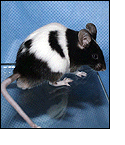Return to Online
Education Kit
|
 |
 |
 Previous Event | Next Event Previous Event | Next Event 
1902: Orderly inheritance of disease observed
 Archibald Garrod observes that the disease alkaptonuria is inherited according to Mendelian rules. Archibald Garrod observes that the disease alkaptonuria is inherited according to Mendelian rules.
Alkaptonuria has several symptoms, including dark urine, dark pigmentation of cartilage and other connective tissue, and arthritis. Vitamin C and a low protein diet can relieve symptoms. In 1902, British physician Archibald Garrod, on the advice of his colleague, Bateson, demonstrated that alkaptonuria is inherited according to Mendelian rules and involves a rare recessive mutation. It was among the first conditions ascribed to a genetic cause. But the gene involved remained unknown until the 1990s.
In 1990, a French group led by J.L. Guenet identified mice with the equivalent of alkaptonuria; blackened wood shavings in the mouse boxes, caused by the mice’s darkened urine, brought the mice to the scientists’ attention. A few years later, they established that the mice carried a mutation on mouse chromosome 16, in a region that matches the long arm of human chromosome 3. Human geneticists soon mapped the alkaptonuria mutation to a small portion of chromosome 3.
In 1996, scientists isolated a gene from the region, which they called HGO. A variety of mutations in the HGO gene can cause alkaptonuria; most of the mutations leading to disease change parts of the gene that normally are conserved between the human gene and the equivalent gene in other species.
More Information
References:
Garrod, A. E. The incidence of alkaptonuria: a study in chemical individuality. Lancet, II:1616-1620. 1902.
Mouse Mapping:
Montagutelli, X., Lalouette, A., Coude, M., Kamoun, P., Forest, M., Guenet, J.-L. aku, a mutation of the mouse homologous to human alkaptonuria, maps to chromosome 16. Genomics, 19(1): 9-11. 1994. [PubMed]
Human Mapping:
Janocha, S., Wolz, W., Srsen, S., Srsnova, K., Montagutelli, X., Guenet, J.L., Grimm, T., Kress, W., Muller, C. R. The human gene for alkaptonuria (AKU) maps to chromosome 3q. Genomics, 19(1):5-8. 1994. [PubMed]
Pollak, M. R., Chou, Y.H., Cerda, J.J., Steinmann, B., La Du, B.N., Seidman, J.G., Seidman, C.E. Homozygosity mapping of the gene for alkaptonuria to chromosome 3q2. Nature Genet, 5(2): 201-204. 1993. [PubMed]
Human Gene Cloning:
Fernandez-Canon, J.M., Granadino, B., Beltran-Valero de Bernabe, D., Renedo, M., Fernandez-Ruiz, E., Penalva, M.A., Rodriguez de Cordoba, S. The molecular basis of alkaptonuria. Nature Genet, 14: 19-24, 1996. [PubMed]
 Previous Event | Next Event Previous Event | Next Event 
Last Reviewed: April 14, 2008
|

